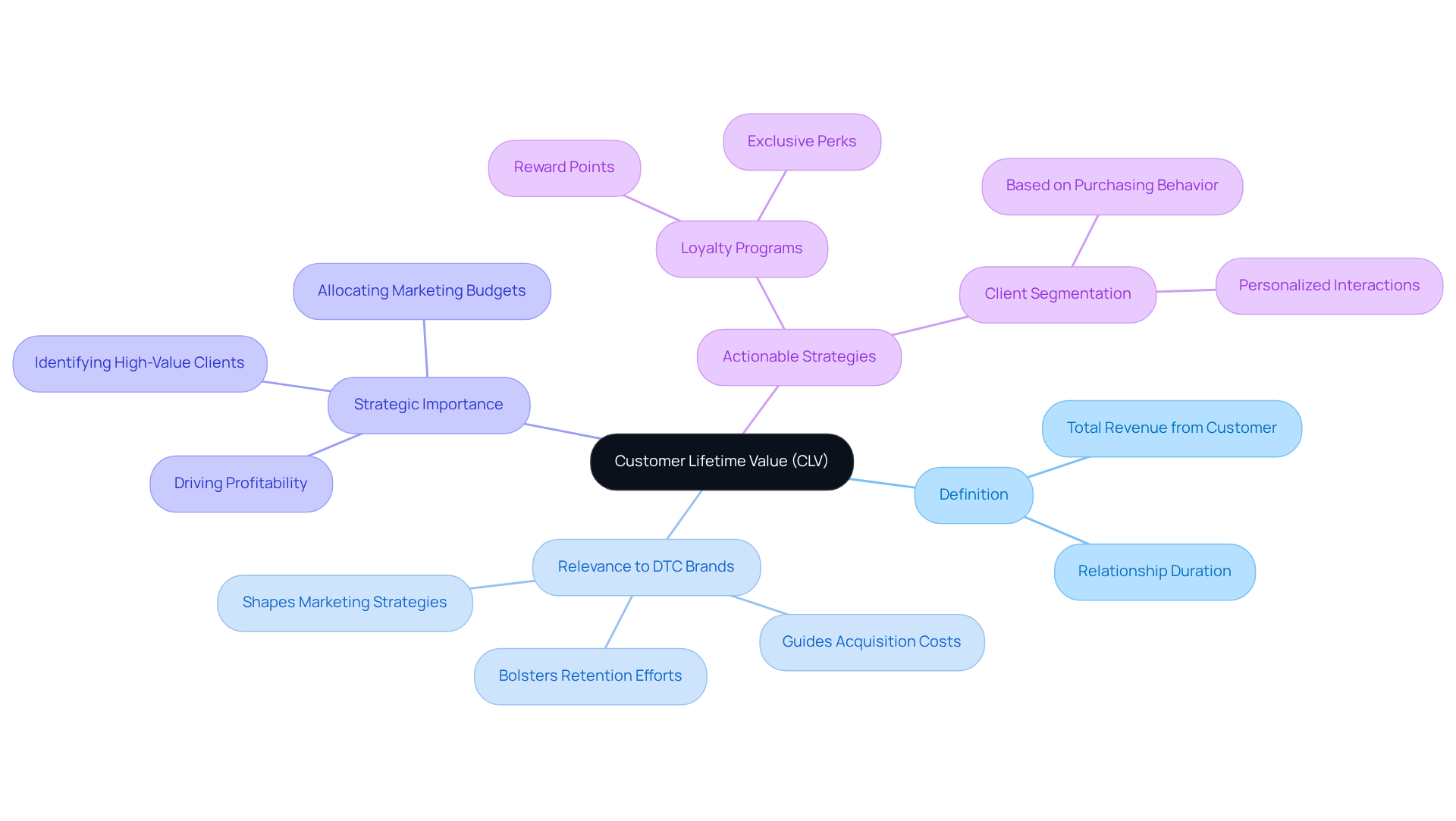
Overview
The significance of Customer Lifetime Value (CLV) for direct-to-consumer (DTC) brands is paramount; it serves as a pivotal tool in shaping marketing strategies, optimizing acquisition costs, and bolstering customer retention efforts. Understanding CLV empowers DTC companies to prioritize high-value clients and customize their marketing initiatives. This strategic focus not only drives profitability but also cultivates enduring customer relationships, positioning brands advantageously in a competitive landscape.
Introduction
Understanding Customer Lifetime Value (CLV) is essential for direct-to-consumer (DTC) brands navigating an increasingly competitive market. This pivotal metric not only informs marketing strategies and client acquisition costs but also enhances retention efforts, ultimately driving profitability. As consumer expectations evolve towards personalized experiences, DTC brands must effectively leverage CLV to foster deeper connections with their customers and ensure sustainable growth.
Define Customer Lifetime Value (CLV) and Its Relevance to DTC Brands
The concept of CLV, or Customer Lifetime Value, represents the total revenue a business can anticipate from an individual throughout their relationship with the company. For direct-to-consumer (DTC) companies, grasping the intricacies of CLV is crucial, as CLV shapes marketing strategies, guides acquisition costs, and bolsters retention efforts.
By centering their focus on CLV, DTC companies can identify and prioritize high-value clients, facilitating a more strategic allocation of marketing budgets and ultimately driving profitability. This metric not only encapsulates the financial worth of clients but also acts as a strategic compass for long-term business planning, making it indispensable for achieving CLV in an increasingly competitive DTC landscape.
Furthermore, brands that cultivate a robust sense of community among their customers witness significantly higher revenue growth rates compared to those that do not foster such connections. With 71% of consumers expecting personalized interactions, can further amplify customer lifetime value (CLV).
Implementing actionable strategies, such as:
- Creating loyalty programs
- Segmenting clients based on purchasing behavior
can also greatly enhance retention and CLV.

Trace the Evolution of Customer Lifetime Value in Marketing
The concept of CLV, or Customer Lifetime Value, emerged in the 1980s as businesses began shifting their focus from short-term transactions to cultivating long-term relationships with clients. Initially, CLV was primarily employed in direct marketing to assess the profitability of client acquisition strategies. However, advancements in data analytics and relationship management (CRM) systems have since evolved CLV into a sophisticated metric that considers various factors, including purchase frequency, average order value, and retention rates.
Today, CLV is integral to marketing strategies, guiding businesses in enhancing client loyalty and optimizing resource allocation. Research indicates that acquiring a new client can be up to 25% more expensive than retaining an existing one, underscoring the financial implications of prioritizing CLV. Furthermore, the probability of selling to a current client is up to 14 times higher than that of selling to a new client, as noted by David Reibstein.
To effectively enhance CLV, direct-to-consumer (DTC) brands should implement strategies such as:
- Promoting relevant products at checkout
- Offering incentives for new items
Understanding client behaviors and segmentation is crucial for , ultimately leading to sustainable growth.

Break Down the Components and Calculation of CLV
Determining CLV (Client Lifetime Value) encompasses several vital elements: average transaction value, transaction frequency, and client lifespan. The formula for CLV is expressed as:
CLV = (Average Purchase Value) x (Purchase Frequency) x (Customer Lifespan).
Average Transaction Value (ATV) is calculated by dividing total revenue by the number of transactions. This metric provides insight into how much individuals spend on average per transaction, establishing a foundational understanding of client behavior.
Purchase Frequency (PF) indicates how often an individual makes an acquisition within a specific timeframe. This measure is crucial for understanding , as it reveals patterns in purchasing behavior.
Client Lifespan (CL) reflects the average length of time an individual remains involved with the company. It serves as a key indicator of client retention and loyalty. Typically, customer lifespan is calculated by averaging the duration between a customer's first and final transaction, which can be approximately 10 years for many Direct-to-Consumer (DTC) companies.
By comprehensively understanding these components, DTC companies can effectively tailor their marketing strategies to enhance their CLV. For instance, increasing buying frequency through loyalty initiatives and personalized communications can significantly elevate total revenue. Studies show that personalization can lead to a revenue increase of 10 to 15 percent. Furthermore, prolonging client lifespan by enhancing experiences and support fosters stronger loyalty and repeat purchases; in fact, 93% of clients are likely to make repeat purchases with companies that provide outstanding service.
As brands focus on these metrics, they align their efforts with long-term profitability and sustainable growth. Segmenting clients according to their CLV enables more focused marketing initiatives, ensuring that resources are allocated efficiently. As retention researcher Ali Cudby points out, it costs six to seven times more to acquire a new client than it does to retain existing clients, which underscores the importance of focusing on CLV.

Highlight the Strategic Importance of CLV for DTC Brands
The strategic significance of CLV for DTC companies is paramount. By focusing on CLV, companies can make informed decisions about:
- Client acquisition expenses
- Marketing budgets
- Product development
A company that understands its CLV can afford to invest more in acquiring clients likely to generate higher CLV, thereby optimizing their return on investment. Moreover, insights derived from CLV can inform retention strategies, enabling companies to create personalized experiences that foster loyalty and encourage repeat purchases. Ultimately, leveraging CLV empowers DTC brands to construct that prioritize long-term customer relationships over short-term sales by focusing on CLV.

Conclusion
Understanding Customer Lifetime Value (CLV) is paramount for direct-to-consumer (DTC) brands striving to excel in a competitive landscape. By fully recognizing the financial potential embedded in each customer relationship, DTC companies can strategically allocate resources, enhance their marketing efforts, and ultimately drive profitability. This emphasis on CLV not only aids in identifying high-value customers but also informs long-term business strategies that prioritize sustainable growth over fleeting gains.
The article underscores several critical dimensions of CLV, including its historical evolution, the components that contribute to its calculation, and its strategic significance in shaping marketing and acquisition strategies. Key insights reveal that investing in customer retention is markedly more cost-effective than acquiring new clients, highlighting the necessity for personalized experiences and robust loyalty programs. Furthermore, a comprehensive understanding of the metrics that define CLV—such as average transaction value, purchase frequency, and customer lifespan—empowers DTC brands to tailor their marketing initiatives with precision.
Ultimately, prioritizing CLV transcends mere financial strategy; it serves as a pathway to nurturing enduring customer relationships that cultivate loyalty and encourage repeat business. As DTC brands navigate an ever-evolving marketplace, embracing the principles of CLV will enable them to forge more meaningful connections with their customers, driving both growth and profitability. Brands are urged to leverage this profound understanding of CLV to refine their marketing strategies, ensuring that every customer interaction contributes to a more sustainable and successful business model.
Frequently Asked Questions
What is Customer Lifetime Value (CLV)?
Customer Lifetime Value (CLV) is the total revenue a business can expect from an individual customer throughout their relationship with the company.
Why is CLV important for direct-to-consumer (DTC) brands?
CLV is crucial for DTC brands as it shapes marketing strategies, guides acquisition costs, and strengthens retention efforts, ultimately driving profitability and long-term business planning.
How can DTC companies use CLV to their advantage?
By focusing on CLV, DTC companies can identify and prioritize high-value clients, enabling a more strategic allocation of marketing budgets.
What role does community play in enhancing CLV for brands?
Brands that build a strong sense of community among their customers experience significantly higher revenue growth rates compared to those that do not foster such connections.
How does personalization affect CLV?
With 71% of consumers expecting personalized interactions, emphasizing personalization can significantly enhance customer lifetime value (CLV).
What strategies can help improve retention and CLV?
Actionable strategies to enhance retention and CLV include creating loyalty programs and segmenting clients based on their purchasing behavior.
FAQs











